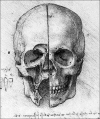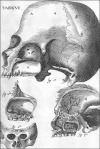Evolution of the paranasal sinuses' anatomy through the ages
- PMID: 24386595
- PMCID: PMC3875840
- DOI: 10.5115/acb.2013.46.4.235
Evolution of the paranasal sinuses' anatomy through the ages
Abstract
Previously, anatomists considered paranasal sinuses as a mysterious region of the human skull. Historically, paranasal sinuses were first identified by ancient Egyptians and later, by Greek physicians. After a long period of no remarkable improvement in the understanding of anatomy during the Middle Ages, anatomists of the Renaissance period-Leonardo da Vinci and Vesalius-made their own contribution. Nathaniel Highmore's name is also associated with the anatomy of paranasal sinuses as he was first to describe the maxillary sinus.
Keywords: Anatomy; History; Paranasal sinuses.
Figures



References
-
- Nall GH. Macmillan's elementary Latin-English dictionary. London: Macmillan and Co. Ltd; 1964.
-
- Gazi A. Dictionary of the Greek language. Athens: Mati; 1839.
-
- Lascaratos JG, Segas JV, Trompoukis CC, Assimakopoulos DA. From the roots of rhinology: the reconstruction of nasal injuries by Hippocrates. Ann Otol Rhinol Laryngol. 2003;112:159–162. - PubMed
-
- Tange RA. Some historical aspects of the surgical treatment of the infected maxillary sinus. Rhinology. 1991;29:155–162. - PubMed
Publication types
LinkOut - more resources
Full Text Sources
Other Literature Sources
